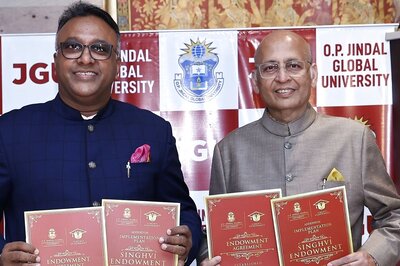
views
The revival of Jet Airways, an airline gasping for breath as lenders remain undecided on how to bring it back to life, was never going to be easy.
First up, the involvement of the government in saving a private business from collapse may have been good pre-poll optics but is bad economics, any way one looks at it.
It is Indian taxpayers who will foot the bill of multiple mistakes committed by the airline’s management. Second, lenders led by some of India’s largest state owned banks, are obviously still sceptical of Jet’s long term revival and ability to sustain business.
Which is why they remain undecided on even the need to infuse emergency funds into the airline and its situation continues to worsen.
Third, by bypassing the Insolvency and Bankruptcy (IBC) process and instead trying to revive Jet by debt restructuring (and converting debt into equity), the lenders have not been able to rule out the return of the errant promoter – Naresh Goyal – who may want to wrest back control after lenders agree to a possible large haircut.
As lenders hold an emergency meeting this morning with all other stakeholders on the way forward, it is pertinent to remember why allowing Goyal to come back could be a wrong move, at several levels.
Over the last several days, several news reports have suggested that Goyal has already expressed his interest in returning to the airline from which he was ousted just last month by the consortium of lenders. Goyal has neither confirmed nor denied these reports. Some reports say he has tied up with other deep-pocketed investors for the bid while one report this morning said that Goyal’s bid came a few minutes after the deadline for bids had expired and could therefore be disqualified.
So why is Goyal keen on returning to the airline which has virtually been run aground? This could be a case of his inability to keep away from a business he built from scratch and took to commanding heights – remember, Jet was the second largest airline by passengers till the beginning of this calendar year.
For years, it was the only true blue competitor to Air India on international routes and is synonymous with high service standards. Second, Goyal has almost always managed to influence policy to suit the needs of his airline – this was evident in his ability to keep foreign airlines completely barred from investing in Indian airlines for years till 2012, when the UPA government allowed foreign carriers to take up to 49% equity in an Indian airline.
Once the bar on foreign airlines was lifted, though, Jet was the first to get a 24% investment from Abu Dhabi based Etihad Airways!
Goyal is also believed to have influenced many other policy decisions including the controversial 5/20 rule, which placed severe restrictions on new Indian airlines flying overseas. This rule was eased just a few years back. Having been largely successful in getting policy decisions tweaked to his benefit, Goyal may be thinking of similar ease of doing business in the future too, for operating in a market which is one of the fastest growing in the world right now.
But whatever be his reasons for wanting to return to the Jet cockpit, Goyal should be kept out. Why should the promoter who ran the airline aground be trusted with its revival? When Goyal was forced to leave the airline’s chairmanship and his board seat by lenders last month, the airline had known debt of over Rs 8500 crore and unspecified additional liabilities to suppliers and vendors.
It isn’t difficult to see that if at all any new set of investors comes in and the airline is on its path to revival, existing lenders will have to take substantial haircuts. So should Goyal (if his consortium is allowed to bid for and run Jet) benefit from these haircuts? Allowing Goyal to come back to the airline is akin to waiving off a major portion of the liabilities the airline accumulated under his stewardship.
How can this be right, as the hair cuts are going to be taken by state owned lenders – which in effect means the Indian tax payers. Should the tax payers be bailing out Goyal?
Besides, another question seems pertinent. If Goyal is indeed teaming up with investors to bid for Jet, could the airline not have arranged for funds earlier under his chairmanship and saved itself from the present state of near collapse?
The eagerness of Goyal to return follows a clear statement from State Bank of India Chairman Rajneesh Kumar a few weeks back, where he had said that Goyal could also place a bid when the bidding process got started. This is precisely what Goyal seems to have done!
This state of affairs brings us back to the government, its prioritisation of optics over economics and the weak revival plan stitched together by lenders who were prodded by the government.
By bypassing the IBC process, not only have lenders (and by extension the government) left all attempts at revival at risk, they now cannot possibly bar Goyal’s return. Remember, Goyal would have been barred from bidding had the revival been done under the provisions of the IBC.
The long-drawn case of a steel major, which was heavily in debt and dragged to the IBC process by lenders, is pertinent here. The errant promoters of this steel major also wanted to get back control and have since thwarted every attempt at revival of this company. This, despite a well-known international steel major having already won a bid to take control.
In Jets case, unless the lenders and the government officials steering its revival get their basics clear, this revival is difficult. Is Jet being saved because of only political expediency or is it being saved with long term revival plan in force? Some experts are suggesting that the airline should be allowed to cease operations - and perhaps this may not be all that bad piece of an advice.
(The author is a senior journalist. Views expressed are personal)




















Comments
0 comment